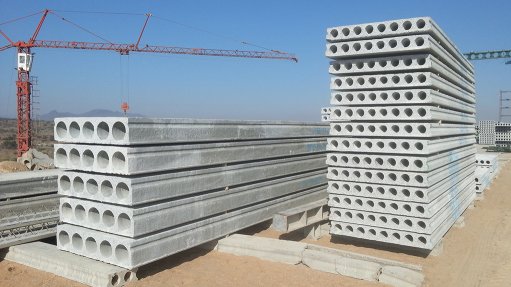
PRECAST PREFERENCE The elements are manufactured in a controlled factory environment and then transported to site where they are assembled
The precast-concrete manufacturing sector is complementing conventional in-situ building methods by helping to accelerate strategic infrastructure projects and reducing construction costs.
It is also augmenting the public sector’s drive to use infrastructure projects to create employment and skills development opportunities, considering the many sustainable and quality jobs that these factories create.
This stands out as a major milestone for local precast-concrete systems manufacturer Corestruc MD Willie de Jager.
“As precast concrete technologies continue to gain traction in the South African construction sector, it is inevitable that the industry will continue to invest heavily into its human resources. This is considering the level of skills that are required in the various specialist components of the precast concrete construction value chain, which spans the design and efficient manufacture of quality items through to the rapid and accurate installation of the precast concrete elements on site,” De Jager says.
The high number of hybrid-concrete construction projects in the country, with its intense focus on labour-based construction methods, bears testament to the coming of age of precast concrete.
For example, many reservoirs in the country are now being built using Corestruc’s modular precast-concrete system owing to the rapid rate at which these structures can be built.
A 10 Mℓ reservoir can be built in only six weeks using the company’s sophisticated precast-concrete system. This contrasts with the four to six months to construct the reservoir wall using conventional in-situ techniques, and considering the technically complex nature of these construction projects, does not come with the risk of having to redo the work.
The various precast concrete elements, including the columns and hollow-core slabs that constitute the roof structure, as well as the walls and buttress panels, are manufactured in a controlled factory environment. These elements are then transported to site where they are installed by the company’s team.
Corestruc continues to work alongside emerging contractors on these Expanded Public Works Programme (EPWP) projects.
The EPWP is one of government’s key initiatives geared at poverty and income relief by creating temporary work for the unemployed. This national programme covers all spheres of government and State-owned enterprises, providing an important avenue for labour absorption and income transfers to poor households in the short to medium term.
EPWP projects employ workers on a temporary or ongoing basis with government, contractors, or other nongovernmental organisations under the Ministerial Conditions of Employment for the EPWP or learnership employment conditions.
Moreover, the emerging contractors working on these reservoir projects have met all their social-enterprise development obligations. They are tasked with building the ancillary infrastructure, including the pipeline, while Corestruc constructs the reservoir.
The extensive quality controls in place at Corestruc’s factory have been a major selling point for the civil engineers who have promoted the system to municipal officials.
The factory is essentially the “heart” of two new reservoir construction projects that consulting engineering firm Tango’s Consultants is undertaking on behalf of the City of Ekurhuleni metropolitan municipality in Springs, Gauteng.
Tango’s Consultants, a division of the Tango’s Group, was appointed the design engineer and is now supervising the construction works, with contractor Anita Building as the principal contractor.
While the cost of Corestruc’s system is comparative to in-situ techniques on smaller structures, it provides a more affordable means of constructing larger reservoirs.
De Jager concludes that this is where the real value of the system will be realised, considering the growing backlog in water infrastructure and the pressure municipalities are under to better manage their dwindling budgets.